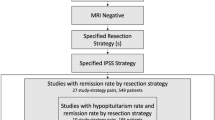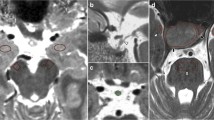Abstract
Introduction
Delayed hypopituitarism is the most common complication after stereotactic radiosurgery (SRS) for pituitary adenomas. The aim of this study was to investigate the relationship between the distance from the hypothalamic-pituitary axis to the treatment target and anterior pituitary function preservation after SRS.
Methods
Between 2007 and 2020, consecutive adult patients who underwent single-session SRS for non-functioning or hormone-secreting pituitary adenomas with ≥ 6 months of follow-up were included. Distance measurements between hypothalamic-pituitary axis structures and the SRS target volume were quantified on MRI. The primary outcome was anterior pituitary function preservation. Outcomes were compared using multivariable regression and area under the receiver operator characteristic curve (AUROC) analyses.
Results
The study cohort comprised 224 patients, who were categorized by preservation (n = 168) and no preservation (n = 56) of anterior pituitary function after SRS. The mean and median clinical follow-up durations were 53.7 (38.0) and 46.0 (17.0–75.0) months, respectively. Independent predictors of anterior pituitary function preservation were a greater distance between the center of the pituitary gland and center of the SRS target [OR 1.101 (1.000–1.213), p = 0.050], and a shorter clinical follow-up duration [OR 0.985 (0.977–0.993), p < 0.0001]. The adjusted AUROC for the distance from the center of the pituitary gland and center of the SRS target in predicting anterior pituitary function preservation was 0.595. The sensitivity, specificity, positive predictive value and negative predictive value in predicting anterior pituitary function preservation at the optimal cut-off distance of 15 mm were 30.0, 88.0, 89.9 and 26.2%, respectively.
Conclusions
Greater distance between the normal pituitary gland and the SRS target is associated with anterior pituitary function preservation and increasing this distance should be a goal of adenoma resection. Larger prospective, multi-center studies are necessary to corroborate this finding and establish the effects of distance on hypopituitarism after SRS for pituitary adenomas.





Similar content being viewed by others
Data availability
This study data is available from the corresponding author upon reasonable request.
References
Ezzat S, Asa SL, Couldwell WT et al (2004) The prevalence of pituitary adenomas: a systematic review. Cancer 101:613–619
Hayhurst C, Taylor PN, Lansdown AJ, Palaniappan N, Rees DA, Davies JS (2020) Current perspectives on recurrent pituitary adenoma: the role and timing of surgery vs adjuvant treatment. Clin Endocrinol (Oxf) 92:89–97
Dekkers OM, Pereira AM, Roelfsema F et al (2006) Observation alone after transsphenoidal surgery for nonfunctioning pituitary macroadenoma. J Clin Endocrinol Metab 91:1796–1801
Castro DG, Cecílio SA, Canteras MM (2010) Radiosurgery for pituitary adenomas: evaluation of its efficacy and safety. Radiat Oncol 5:109
Ding D, Starke RM, Sheehan JP (2014) Treatment paradigms for pituitary adenomas: defining the roles of radiosurgery and radiation therapy. J Neurooncol 117:445–457
Kotecha R, Sahgal A, Rubens M et al (2020) Stereotactic radiosurgery for non-functioning pituitary adenomas: meta-analysis and International Stereotactic Radiosurgery Society practice opinion. Neuro Oncol 22:318–332
Zibar Tomšić K, Dušek T, Kraljević I et al (2017) Hypopituitarism after gamma knife radiosurgery for pituitary adenoma. Endocr Res 42:318–324
Cordeiro D, Xu Z, Mehta GU et al (2018) Hypopituitarism after Gamma Knife radiosurgery for pituitary adenomas: a multicenter, international study. J Neurosurg. https://doi.org/10.3171/2018.5.JNS18509
Ehrnborg C, Hakkaart-Van Roijen L, Jonsson B, Rutten FF, Bengtsson BA, Rosén T (2000) Cost of illness in adult patients with hypopituitarism. Pharmacoeconomics 17:621–628
Tomlinson JW, Holden N, Hills RK et al (2001) Association between premature mortality and hypopituitarism. West Midlands prospective hypopituitary study group. Lancet 357:425–431
Pomeraniec IJ, Taylor DG, Cohen-Inbar O, Xu Z, Lee Vance M, Sheehan JP (2019) Radiation dose to neuroanatomical structures of pituitary adenomas and the effect of Gamma Knife radiosurgery on pituitary function. J Neurosurg 132:1499–1506
von Elm E, Altman DG, Egger M, Pocock SJ, Gøtzsche PC, Vandenbroucke JP (2007) The strengthening the reporting of observational studies in epidemiology (STROBE) statement: guidelines for reporting observational studies. Lancet 370:1453–1457
Youden WJ (1950) Index for rating diagnostic tests. Cancer 3:32–35
Taussky P, Kalra R, Coppens J, Mohebali J, Jensen R, Couldwell WT (2011) Endocrinological outcome after pituitary transposition (hypophysopexy) and adjuvant radiotherapy for tumors involving the cavernous sinus. J Neurosurg 115:55–62
Nomikos P, Ladar C, Fahlbusch R, Buchfelder M (2004) Impact of primary surgery on pituitary function in patients with non-functioning pituitary adenomas—a study on 721 patients. Acta Neurochir (Wien) 146:27–35
Kelly DF, Fatemi N, Dusick J (2010) Pituitary hormonal loss and recovery after transsphenoidal adenoma removal. Neurosurgery 67:E221
Alexopoulou O, Everard V, Etoa M et al (2021) Outcome of pituitary hormone deficits after surgical treatment of nonfunctioning pituitary macroadenomas. Endocrine 73:166–176
Toogood AA (2004) Endocrine consequences of brain irradiation. Growth Horm IGF Res 14(Suppl A):S118–S124
Darzy KH (2009) Radiation-induced hypopituitarism after cancer therapy: who, how and when to test. Nat Clin Pract Endocrinol Metab 5:88–99
Li X, Li Y, Cao Y et al (2017) Safety and efficacy of fractionated stereotactic radiotherapy and stereotactic radiosurgery for treatment of pituitary adenomas: a systematic review and meta-analysis. J Neurol Sci 372:110–116
Oh JW, Sung KS, Moon JH et al (2018) Hypopituitarism after Gamma Knife surgery for postoperative nonfunctioning pituitary adenoma. J Neurosurg 129:47–54
Gopalan R, Schlesinger D, Vance ML, Laws E, Sheehan J (2011) Long-term outcomes after Gamma Knife radiosurgery for patients with a nonfunctioning pituitary adenoma. Neurosurgery 69:284–293
Webb SM, Crespo I, Santos A, Resmini E, Aulinas A, Valassi E (2017) MANAGEMENT OF ENDOCRINE DISEASE: quality of life tools for the management of pituitary disease. Eur J Endocrinol 177:R13-r26
Zhang J, Wang Y, Xu X, Gu Y, Huang F, Zhang M (2020) Postoperative complications and quality of life in patients with pituitary adenoma. Gland Surg 9:1521–1529
Johnson MD, Woodburn CJ, Vance ML (2003) Quality of life in patients with a pituitary adenoma. Pituitary 6:81–87
Feigl GC, Pistracher K, Berghold A, Mokry M (2010) Pituitary insufficiency as a side effect after radiosurgery for pituitary adenomas: the role of the hypothalamus. J Neurosurg 113(Suppl):153–159
Yu J, Li Y, Quan T et al (2020) Initial Gamma Knife radiosurgery for nonfunctioning pituitary adenomas: results from a 26-year experience. Endocrine 68:399–410
Xu Z, Lee Vance M, Schlesinger D, Sheehan JP (2013) Hypopituitarism after stereotactic radiosurgery for pituitary adenomas. Neurosurgery 72(630–637):636–637
Feigl GC, Bonelli CM, Berghold A, Mokry M (2002) Effects of gamma knife radiosurgery of pituitary adenomas on pituitary function. J Neurosurg 97:415–421
Funding
None.
Author information
Authors and Affiliations
Contributions
All authors contributed to the study conception and design. Material preparation, data collection and analysis was performed by NI. Statistical guidance was provided by ZX and C-JC. The first draft of the manuscript was written by NI and all authors commented on previous versions of the manuscript. All authors read and approved the final manuscript.
Corresponding author
Ethics declarations
Conflict of interest
The authors declare no conflict of interest.
Ethical approval
This article utilizes retrospective data and does not contain any studies with human participants performed by any of the authors.
Additional information
Publisher's Note
Springer Nature remains neutral with regard to jurisdictional claims in published maps and institutional affiliations.
Rights and permissions
About this article
Cite this article
Ironside, N., Snyder, H., Xu, Z. et al. Effect of distance from target on hypopituitarism after stereotactic radiosurgery for pituitary adenomas. J Neurooncol 158, 41–50 (2022). https://doi.org/10.1007/s11060-022-04007-6
Received:
Accepted:
Published:
Issue Date:
DOI: https://doi.org/10.1007/s11060-022-04007-6




